Choosing a prime rib at the holidays is nearly just as traditional as finding the perfect tree and selecting the right gift for loved ones. But how many times have folks stood in front of the meat counter or home deep freeze pondering that which is considered one of the truly prized cuts from a beef carcass – the prime rib – and had a multitude of questions leap into one’s head like the infamous sugar plum fairies of the season? Questions like:
- Is this the right cut?”
- “How much prime rib do I need?”
- “Should I buy a fresh or frozen prime rib?”
- “How in the heck do you cook this beast?”
Well, I’m glad you asked. Let’s mull over a few of these quandaries in preparation for the occasion.
First off, what is a prime rib? The most common form of a prime rib would be what is called a standing rib roast or a bone-in ribeye. This will be the roast commonly cut into ribeye steaks but left in a larger form with the bone attached. I adore the rib bones that come off of a roasted prime rib, as they are super flavorful and fun to eat.
However, the bones can be a little tricky when it comes to carving the roast after it is cooked – therefore, we do also have the option of a boneless prime rib, also simply called a boneless ribeye roast. Either way, a prime rib is a roast that comes from the rib primal on a beef carcass and is recognizable by the features that make it look similar to a ribeye steak when viewed from the ends.
Timely tips
A little-known fact about the prime rib, however, is that it is not always necessarily USDA Prime. Remember, the three main grades of beef in the U.S. are Select, Choice and Prime; one could think of these as “good,” “better” and “best,” respectively. As you progress from Select to Prime, you will also improve the overall eating experience, but be aware that you will observe an increase in price. Prime rib is merely the way we in the meat trades describe a beef ribeye roast. However, it does often result in a great eating experience, even if it is from the lower grades. Personally, I try to find a prime rib that is at least USDA Choice grade to ensure enough marbling for the great beef flavor that satisfies even the most discerning palates.
Prime rib is a great roast for gatherings and celebrations. An often-asked inquiry is approximately how much meat to budget for when preparing prime rib. According to my friend Chef Michael Ollier, as a rule of thumb, consider a half of a pound (raw) of boneless prime rib roast for each person attending the meal. If you’re planning for the traditional standing rib roast, the recommendation is for three-quarters of a pound per person. However, if the diners are big beef eaters, which assumingly the majority of readers in this magazine are, it’s recommended to increase the per-person quantity by 25% or 30%.
Prime rib at the holidays, when purchased at a grocery store, can often carry a rather hefty price tag. This is a direct cause of supply and demand. That’s why it’s a good idea to consider previously frozen product as a roast. We should not be afraid of frozen meat. In fact, freezing will actually tenderize meat to an extent. The great thing about buying previously frozen prime rib during the holidays is: It may have been purchased at a time during the year that the wholesale price of prime rib was much lower. This can help ease the financial burden of enjoying the ultimate beefy treat.
The preparation
What about the final step in perfecting the prime rib experience – the preparation? A good, high-quality cut of prime rib really only needs a half-and-half mixture of salt and pepper to bring out the amazing beef flavor; a generous sprinkling should do it, but be careful to not overpower the meat itself. However, if you have a favorite seasoning blend, don’t be afraid to use that; just be sure to use it sparingly. Beef flavor is unlike any other red meat; allow the flavor of the beef to be the main event and, if after the first bite one feels it needs more seasoning, consider having that on hand to amend as needed.
Cooking a prime rib should not be intimidating. To get a nice brown and flavorful crust on the surface of the roast, preheat the oven to 450ºF and roast uncovered at that temperature for 15 minutes. Following the initial sear time, drop the oven down to 350ºF for the remainder of the cooking time. Generally speaking, you’ll cook for about 15 minutes for each pound of raw meat you start with; however, it is highly recommended to use a cooking thermometer to achieve that perfect doneness:
- Rare: 125ºF – Cold red center
- Medium-rare: 135ºF – Warm red center
- Medium: 145ºF – Warm pink center
- Medium-well: 150ºF – Slightly pink center
- Well-done: 160ºF – Little to no pink
Once the desired doneness is achieved, be sure to allow the roast to rest for 15 minutes. Resting will help to maintain the juiciness of the roast prior to slicing. And of course, the last and final step – enjoy. Happy holidays. Go beef!








